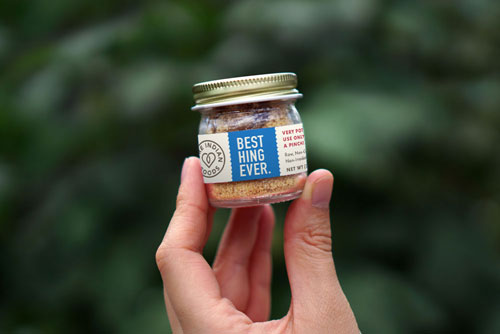Hing (Asafoetida)
Species: Ferula assa-foetida
Other names: A Wei, Asafétida, Ase Fétide, Assant, Crotte du Diable, Devil’s Dung, Ferula Asafoetida, Ferula Assa Foetida, Ferula assa-foetida, Ferula foetida, Ferula pseudalliacea, Ferula rubricaulis, Férule, Férule Persique, Food of the Gods, Fum, Giant Fennel, Heeng, Hing.
Hing, or Asafoetida, is a treasured spice derived from the hard pungent-smelling resin of a large perennial fennel plant native to Iran, Afghanistan and Turkistan, and cultivated in India. The sap is extracted from the stems and root of the fennel, which then hardens into a brownish-yellow sap.
Perhaps no other food has caused such controversy when it comes to loving or hating the pungent smell of raw hing. Raw hing has been called both “Devil’s Dung” due to the strong smell and “God’s Food” because it’s so good for you. Numerous studies have been done on the benefits of this spice!
In English, it is called both “hing” and “asafoetida.” Asa is a Latinized form of the Persian word azā, which means “resin.” The Latin foetidus means “smelling, fetid.” The smell—and thus the flavor—of raw hing is highly pungent when raw, but when the right amount is heated in a fat, such as ghee, the aroma and flavor mellow beautifully. It blends well with a variety of aromatic dishes, hinting at the presence of fragrantly sautéed leeks, onions, shallots and garlic.
Its characteristic odor comes from sulfur compounds in the fennel resin; some people love it, some people hate it. Just like onions or garlic. The resin is most commonly ground and mixed with stabilizers such as wheat or rice flour, or gum arabic to keep it from clumping and make it easier to use.
Hing is an essential ingredient in Southern Indian vegetarian cooking, and an ideal substitute for onion and garlic. This is especially good news for anyone following diet, such as low FODMAP diet in which onions and garlic are restricted. Simply mix a pinch of hing with 1 tsp of ghee, olive oil, or sesame oil; sauté and add to cooked grains, legumes, or vegetables.
So how else can you use hing?
- Traditionally, hing has been used as a digestive aid, added to legumes (beans and peas) and gas-producing vegetables as an anti-flatulent. Add a bit to a large pot of beans or lentils when cooking.
- Combine a pinch of hing powder with 1 TBSP ghee in a saucepan. Sauté a colorful variety of broccoli, cauliflower, carrots, zucchini or yellow squash. Season with salt and pepper.
- Combine a pinch of hing powder with 1 TBSP ghee in a saucepan. Sauté leafy greens such as kale, collards, chard or spinach. Add curry powder and a splash of coconut milk.
- Scramble eggs with a pinch of hing and pure ghee or butter. Add any other vegetables you want.
- Combine a pinch of hing powder with 1 TBSP ghee and 1 tsp curry powder, and cook for a few seconds. Add grains such as millet or rice. Fry just a moment, then add broth or water and cook as normal.
- In a saucepan, heat cooked chickpeas in a mixture of ghee and a pinch of hing. Add spices to taste such as salt, pepper, curry powder, turmeric, cumin and coriander. Serve over rice or quinoa.
- Stir a little hing and ghee into favorite onion-and-garlic-free pasta sauce for delicious, FODMAP-friendly marinara sauce.
- Add a little hing and turmeric to sautéed ground beef, chicken or turkey when making chili, Sloppy Joes, or spaghetti with meat sauce.
I am a foodie, and I love hing. I remember while growing up in India, my mother would give a “tadka” of hing in ghee (sauté hing in ghee) and add it to the food she prepared. The whole kitchen would be filled with beautiful aroma. She wouldn’t have to “text” family members to come for the meal; everyone just rushed to the kitchen right away. However, the terrible quality of Hing available in the U.S. market shocked me. I started my search for a good quality hing. It took me several years and multiple International national trips, after which I discovered this lovely fragrant hing. It is up to 10x stronger than other compound hing powders found in the market. You need to use only a pinch. This hing powder reminds me of my childhood memories and all the hearty meals that my mom prepared for our family. Give it a try and let me know how you liked it. If you love hing like I do, then this is the hing powder that you have been looking for.
Your foodie friend,
Sandeep Agarwal, Herbalist
At Pure Indian Foods, we sell pure, pleasantly aromatic hing powder. This hing powder is 8-10 times stronger than most compound hing powder sold in grocery stores. It is very potent, and a little goes a long way. Our pure aromatic raw hing contains only the minimum amount of edible gum (Gum arabic) to make an easy-to-use powder. Edible gum is the hardened sap of acacia trees. It is Raw, Non-GMO, and Non-Irradiated.



Is hing good for parisites and if so how do u repair it my great grandmother used it in a medicine pouch she wore around her neck when she would take care of people by horseback. Would help her not to catch what they had and a sm block of champor in it also interesting to find out more on hing. I wear it in her Indian medicine pouch I wear as well ty